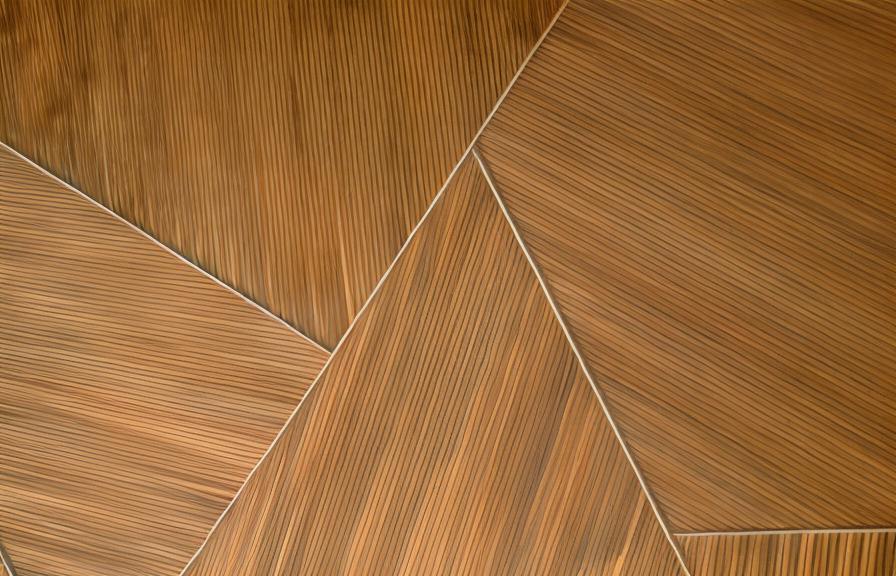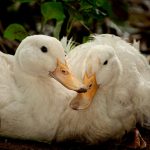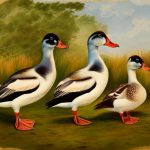Wood ducks, also known as Carolina ducks, are one of the most colorful and stunningly beautiful waterfowl species in North America. They are known for their vibrant plumage and unique markings, making them a favorite among birdwatchers and wildlife enthusiasts. Wood ducks are found in wooded swamps, marshes, and shallow lakes across the eastern United States and parts of Canada. They are also commonly found in wooded areas near rivers and streams. These ducks are known for their distinctive crested heads, red eyes, and iridescent green and purple plumage. The male wood duck, also known as a drake, is particularly striking with its bold colors and intricate patterns. The female wood duck, or hen, is more subtly colored with a mottled brown appearance that provides excellent camouflage in their natural habitat. Wood ducks are known for their shy and elusive nature, making them a fascinating subject for birdwatchers and photographers alike.
Wood ducks are cavity nesters, meaning they seek out natural tree cavities or man-made nest boxes to lay their eggs and raise their young. They are highly adaptable and can be found in a variety of habitats, including freshwater marshes, beaver ponds, and flooded forests. These ducks are also known for their strong flying abilities, making them capable of traveling long distances during migration. Wood ducks are omnivorous and feed on a variety of aquatic plants, seeds, insects, and small fish. They are an important part of the ecosystem, contributing to the balance of wetland habitats and serving as indicators of environmental health. Despite their stunning appearance and ecological significance, wood ducks face a number of challenges and threats to their survival, making conservation efforts crucial for their future.
Key Takeaways
- Wood ducks are known for their colorful plumage and unique breeding habits, making them a popular species among bird enthusiasts.
- Male wood ducks have striking iridescent plumage, while females have more subdued colors for camouflage during nesting.
- Wood ducks prefer to nest in tree cavities near water, and they often use abandoned woodpecker holes for their nesting sites.
- Breeding behavior in wood ducks involves elaborate courtship displays and vocalizations to attract a mate.
- The incubation period for wood duck eggs is around 30 days, and the female is solely responsible for incubating the eggs and caring for the ducklings after hatching.
Physical Characteristics of Wood Ducks
Wood ducks are easily recognizable by their striking appearance and unique physical characteristics. The male wood duck is particularly eye-catching with its iridescent green and purple head, red eyes, white throat, and chestnut breast. Its body is adorned with intricate patterns of black, white, and brown feathers, creating a stunning display of color and detail. The female wood duck, on the other hand, is more subtly colored with a mottled brown appearance that provides excellent camouflage in their natural habitat. Both male and female wood ducks have distinctive crested heads and long, broad tails that add to their elegant appearance. Their wings are marked with iridescent patches of blue and green, adding to their overall beauty.
In addition to their vibrant plumage, wood ducks have unique physical adaptations that make them well-suited for their aquatic lifestyle. They have webbed feet that enable them to swim and navigate through water with ease. Their bills are specially designed for foraging in shallow water, allowing them to sift through mud and vegetation in search of food. Wood ducks also have keen eyesight and acute hearing, which helps them detect potential predators and navigate through their wooded habitats. These physical characteristics make wood ducks well-adapted for their natural environment and contribute to their overall beauty and appeal.
Habitat and Nesting Habits
Wood ducks are commonly found in wooded swamps, marshes, and shallow lakes across the eastern United States and parts of Canada. They are also commonly found in wooded areas near rivers and streams. These ducks are known for their preference for wooded habitats with plenty of trees and water sources. Wood ducks are cavity nesters, meaning they seek out natural tree cavities or man-made nest boxes to lay their eggs and raise their young. They are highly adaptable and can be found in a variety of habitats, including freshwater marshes, beaver ponds, and flooded forests.
During the breeding season, male wood ducks engage in elaborate courtship displays to attract females. Once a female has chosen a mate, she will inspect potential nesting sites before making her final selection. The female will then line the chosen cavity with down feathers from her breast to create a soft nest for her eggs. Wood ducks typically lay around 10-15 eggs in a clutch, which will be incubated for about 30 days before hatching. After the eggs hatch, the mother will lead her ducklings to water where they will learn to swim and forage for food. Wood ducks are devoted parents and will fiercely defend their young from predators.
Breeding Behavior and Mating Rituals
Breeding behavior in wood ducks is characterized by elaborate courtship displays and intricate mating rituals. During the breeding season, male wood ducks engage in flamboyant displays to attract females. These displays often involve head bobbing, wing flapping, and vocalizations to demonstrate strength and vitality. Male wood ducks also use their vibrant plumage to impress females, displaying their colorful feathers in an effort to win a mate.
Once a female has chosen a mate, she will inspect potential nesting sites before making her final selection. The female will then line the chosen cavity with down feathers from her breast to create a soft nest for her eggs. Wood ducks typically lay around 10-15 eggs in a clutch, which will be incubated for about 30 days before hatching. During this time, the male will stand guard and protect the female from potential threats while she tends to the eggs.
After the eggs hatch, the mother will lead her ducklings to water where they will learn to swim and forage for food. Wood ducks are devoted parents and will fiercely defend their young from predators. The bond between male and female wood ducks is strong during the breeding season as they work together to ensure the survival of their offspring.
Nesting and Incubation Period
Wood ducks are cavity nesters, meaning they seek out natural tree cavities or man-made nest boxes to lay their eggs and raise their young. The female wood duck will inspect potential nesting sites before choosing a suitable cavity to lay her eggs. She will then line the chosen cavity with down feathers from her breast to create a soft nest for her eggs. Wood ducks typically lay around 10-15 eggs in a clutch, which will be incubated for about 30 days before hatching.
During the incubation period, the female wood duck will diligently tend to her eggs, rarely leaving the nest except to feed briefly. The male wood duck will stand guard nearby, protecting the female from potential threats while she tends to the eggs. Once the eggs hatch, the mother will lead her ducklings to water where they will learn to swim and forage for food.
The nesting and incubation period is a critical time for wood ducks as they work tirelessly to ensure the survival of their offspring. The dedication of both male and female wood ducks during this time is essential for the successful hatching and rearing of their young.
Challenges and Threats to Wood Duck Breeds

Despite their stunning appearance and ecological significance, wood ducks face a number of challenges and threats to their survival. Habitat loss is one of the primary threats facing wood ducks as wetlands are drained for development or converted for agricultural use. This loss of habitat reduces the availability of suitable nesting sites for wood ducks and disrupts their natural breeding behaviors.
In addition to habitat loss, wood ducks are also vulnerable to predation by mammals such as raccoons, mink, and foxes. These predators often target wood duck nests and pose a significant threat to both eggs and ducklings. Human disturbance is another challenge facing wood ducks as increased recreational activities in wetland areas can disrupt nesting behaviors and cause stress to breeding pairs.
Climate change is also a concern for wood ducks as rising temperatures and extreme weather events can impact their natural habitats and food sources. Changes in precipitation patterns can lead to flooding or drought conditions that affect the availability of suitable nesting sites and food resources for wood ducks.
Conservation Efforts and Future Outlook
Conservation efforts play a crucial role in protecting wood duck breeds and ensuring their long-term survival. One of the most effective conservation measures for wood ducks has been the installation of man-made nest boxes in suitable habitats. These nest boxes provide alternative nesting sites for wood ducks in areas where natural cavities may be limited or unavailable.
Habitat restoration projects have also been instrumental in creating suitable breeding grounds for wood ducks by preserving wetland areas and restoring degraded habitats. These efforts help to maintain healthy ecosystems that support the diverse needs of wood ducks throughout their life cycle.
In addition to habitat conservation, predator management programs have been implemented to reduce predation on wood duck nests and increase the survival rates of eggs and ducklings. These programs often involve trapping or relocating predators that pose a threat to nesting wood ducks.
Public education and outreach programs have also played a key role in raising awareness about the importance of conserving wood duck breeds and promoting responsible stewardship of wetland habitats. By engaging local communities in conservation efforts, these programs help foster a sense of stewardship for natural resources and encourage support for ongoing conservation initiatives.
Looking ahead, continued research and monitoring efforts will be essential for understanding the ongoing challenges facing wood duck breeds and developing effective conservation strategies. By working together to address these challenges, we can help ensure a bright future for these stunning waterfowl species for generations to come.
If you’re interested in learning more about wood duck breeds, you might also want to explore the topic of creating a suitable habitat for chickens. Poultry Wizard offers a helpful article on large chicken coop ideas, which can provide valuable insights into designing and building a comfortable and secure environment for your feathered friends. Just as wood ducks require specific nesting conditions, chickens also benefit from well-designed coop spaces to thrive and lay eggs.
FAQs
What is the breeding season for wood ducks?
The breeding season for wood ducks typically occurs from late winter to early spring, with nesting usually taking place between February and June.
How many eggs does a wood duck typically lay?
A female wood duck typically lays around 9-14 eggs in a single clutch, although larger clutches have been recorded.
Where do wood ducks build their nests?
Wood ducks often build their nests in tree cavities, particularly those created by woodpeckers. They may also use nest boxes provided by humans.
How long does it take for wood duck eggs to hatch?
It takes approximately 28-30 days for wood duck eggs to hatch after they have been laid.
Do wood ducks mate for life?
Wood ducks are not strictly monogamous, but they do often form long-term pair bonds. However, they may choose new mates in subsequent breeding seasons.
What is the role of the male wood duck in nesting and breeding?
The male wood duck plays a role in protecting the female and the nesting site, as well as in defending the ducklings after they hatch. He does not typically participate in incubating the eggs.
At what age do wood ducks begin breeding?
Wood ducks typically reach breeding age at around 1 year old, although some may not breed until they are 2 years old.
Meet Walter, the feathered-friend fanatic of Florida! Nestled in the sunshine state, Walter struts through life with his feathered companions, clucking his way to happiness. With a coop that’s fancier than a five-star hotel, he’s the Don Juan of the chicken world. When he’s not teaching his hens to do the cha-cha, you’ll find him in a heated debate with his prized rooster, Sir Clucks-a-Lot. Walter’s poultry passion is no yolk; he’s the sunny-side-up guy you never knew you needed in your flock of friends!







